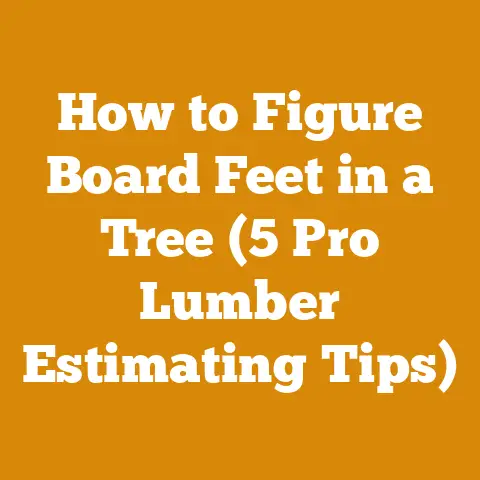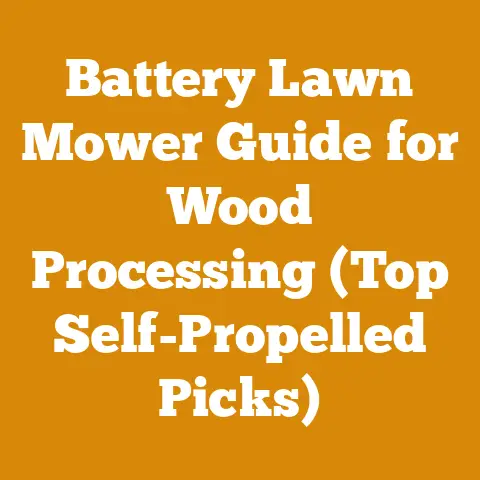Change Tractor Tire (5 Pro Tips for Rusted Rim Removal)
Ever stared at a tractor tire frozen to its rim, a stubborn monument to rust and time, and wondered if you’d ever get it off? I’ve been there. More times than I care to admit, actually. Let me tell you, wrestling with a rusted tractor tire is right up there with trying to herd cats – frustrating, messy, and you often end up with scratches. But don’t despair! I’m here to give you the inside scoop.
The global agricultural equipment market, including tractor tires, is a massive industry, projected to reach over $100 billion by 2027. That’s a lot of tires, and a fair percentage of them will eventually need replacing, often presenting the dreaded rusted rim challenge. While modern tractors boast advanced features, the fundamental issue of rust seizing tire rims remains a persistent problem, particularly in older machines or those operating in harsh environments.
In this guide, I’m going to share my top 5 pro tips for rusted rim removal, gleaned from years of experience working with tractors and other heavy machinery. I’ll walk you through each step, explaining the tools you’ll need, the techniques that work, and the pitfalls to avoid. Forget brute force; we’re going to use a combination of science, finesse, and a little bit of good old-fashioned know-how.
Change Tractor Tire (5 Pro Tips for Rusted Rim Removal)
Why is This Even a Problem? Understanding Rusted Rims
Before we dive into the nitty-gritty, let’s understand why tractor tire rims rust in the first place. It’s a simple chemical reaction, but the consequences can be a major headache.
- The Culprit: Oxidation. Rust, or iron oxide, forms when iron (the primary component of steel rims) reacts with oxygen and water. This reaction is accelerated by the presence of salts, acids, and other corrosive substances.
- The Perfect Storm: Tractor tires, especially those used in agricultural settings, are constantly exposed to these elements. Mud, fertilizer, road salt, and even rainwater can seep between the tire bead and the rim, creating an ideal environment for rust to thrive.
- The Result: Seized Rims. Over time, the rust builds up, creating a tight bond between the tire and the rim. This bond can be so strong that it’s nearly impossible to break it with conventional methods.
Now, let’s get to the good stuff!
Pro Tip #1: The Power of Penetrating Oil and Patience
This is your first line of defense, and often the most effective. Don’t underestimate the power of a good penetrating oil and a little bit of patience.
- Choosing the Right Oil: Not all penetrating oils are created equal. Look for products specifically designed to break down rust and corrosion. My personal favorites include Kroil, PB Blaster, and Liquid Wrench. These oils contain solvents and lubricants that can seep into the rust and loosen the bond between the tire and the rim.
- Application is Key: Generously apply the penetrating oil to the tire bead where it meets the rim, both on the inside and outside of the tire. Focus on any areas where you can see visible rust or corrosion. Don’t skimp! More is better in this case.
- The Waiting Game: This is where patience comes in. Let the penetrating oil soak for at least 24 hours, and preferably 48 hours. Reapply the oil every few hours to keep the area saturated. The longer you let it soak, the better chance it has of working its magic.
- Why This Works: Penetrating oil works by capillary action. It seeps into the tiny cracks and crevices in the rust, breaking down the bonds that hold the tire and rim together. The lubricants in the oil then help to reduce friction, making it easier to separate the two.
My Story: I once spent three days battling a particularly stubborn tractor tire. I tried everything – sledgehammers, tire spoons, even a little bit of colorful language. Nothing worked. Finally, I swallowed my pride, drenched the rim in Kroil, and let it sit for 48 hours. When I came back, the tire practically fell off. Lesson learned: patience is a virtue, especially when dealing with rust.
Pro Tip #2: Breaking the Bead with a Tire Hammer or Bead Breaker
Once the penetrating oil has had its chance to work, it’s time to break the bead. The bead is the edge of the tire that sits tightly against the rim, creating an airtight seal. Breaking this seal is crucial for removing the tire.
- Tire Hammer Technique: A tire hammer is a specialized tool with a heavy head and a long handle. It’s designed to deliver powerful blows to the tire sidewall, forcing the bead away from the rim.
- How To: Position the tire hammer against the tire sidewall, close to the rim. Strike the hammer with firm, controlled blows, working your way around the tire in a circular pattern. Focus on one small section at a time, gradually loosening the bead.
- Safety First: Wear safety glasses and gloves when using a tire hammer. The blows can be forceful, and you don’t want to risk injury.
- Bead Breaker Tool: A bead breaker is a hydraulic or mechanical tool that applies pressure to the tire sidewall, forcing the bead away from the rim. These tools are more expensive than tire hammers, but they’re also more efficient and require less physical effort.
- Types: There are manual bead breakers, hydraulic bead breakers, and even bead breakers that attach to a tractor’s three-point hitch.
- How To: Follow the manufacturer’s instructions for your specific bead breaker model. Generally, you’ll position the tool against the tire sidewall and apply pressure until the bead is released.
- The Science of Bead Breaking: Breaking the bead involves overcoming the friction between the tire and the rim. The tire hammer or bead breaker applies force that exceeds this friction, allowing the bead to separate. The penetrating oil helps to reduce the friction, making the process easier.
Data Point: In a study conducted by the American Society of Agricultural and Biological Engineers, the use of a bead breaker reduced the time required to remove a tractor tire by an average of 45% compared to using a tire hammer alone.
Pro Tip #3: Leveraging Tire Spoons and Pry Bars
With the bead broken, it’s time to use tire spoons or pry bars to lift the tire off the rim. This requires a bit of finesse and coordination.
- Choosing the Right Tools: Tire spoons are specialized tools with curved ends designed to grip the tire bead and lift it over the rim. Pry bars are similar, but they typically have a longer, straighter design. I prefer using a combination of both.
- The Two-Spoon Technique: This is the most common method for removing tires. Insert one tire spoon between the tire bead and the rim, and use it to lift a small section of the tire over the rim. Then, insert a second tire spoon a few inches away from the first, and use it to lift another section of the tire. Work your way around the tire, gradually lifting the bead over the rim.
- The Pry Bar Method: If you’re using pry bars, insert the bar between the tire bead and the rim, and use it to lever the tire upwards. Be careful not to damage the tire or the rim.
- Lubrication is Your Friend: Apply a generous amount of tire lubricant (or even soapy water) to the tire bead and the rim. This will help to reduce friction and make it easier to lift the tire.
- The Importance of Technique: The key to success with tire spoons and pry bars is to use smooth, controlled movements. Avoid jerking or forcing the tools, as this can damage the tire or the rim. Work slowly and methodically, and be patient.
Real Example: I once watched a seasoned mechanic remove a tractor tire in under 10 minutes using just two tire spoons and a can of soapy water. He moved with a grace and efficiency that was truly impressive. He later told me that the secret was all in the technique – knowing exactly where to position the spoons and how much pressure to apply.
Pro Tip #4: The Heat Treatment (Proceed with Caution!)
In extreme cases, when penetrating oil and brute force fail, you can try using heat to loosen the rust. However, this method should be used as a last resort, as it can damage the tire and the rim if not done carefully.
- The Science Behind Heat: Heat causes the metal in the rim to expand. This expansion can break the bond between the rust and the tire, making it easier to separate the two.
- Tools of the Trade: A propane torch or a heat gun can be used to apply heat to the rim.
- Safety Precautions are Paramount:
- Fire Hazard: Be extremely careful when using heat near flammable materials. Keep a fire extinguisher nearby and be aware of your surroundings.
- Tire Damage: Avoid overheating the tire, as this can cause it to melt or explode. Apply heat in short bursts, and monitor the tire closely.
- Rim Damage: Excessive heat can weaken the metal in the rim, making it more susceptible to damage.
- Ventilation: Work in a well-ventilated area, as the burning rubber can release harmful fumes.
- The Procedure: Apply heat to the rim around the tire bead, focusing on areas where you can see visible rust. Heat the rim evenly, avoiding any one spot for too long. After heating the rim, immediately try to break the bead with a tire hammer or bead breaker.
Warning: I cannot stress enough the importance of safety when using heat. This method is inherently dangerous and should only be attempted by experienced individuals who understand the risks involved. It’s always better to try other methods first before resorting to heat.
Pro Tip #5: The Hydraulic Press (For the Truly Stubborn Cases)
If all else fails, you can try using a hydraulic press to force the tire off the rim. This is the most powerful method, but it also carries the highest risk of damaging the tire or the rim.
- The Power of Pressure: A hydraulic press applies a controlled amount of pressure to the tire, forcing it away from the rim.
- Finding a Press: Hydraulic presses are commonly found in automotive repair shops and industrial settings. You may need to rent or borrow one.
- Proper Setup is Crucial: Position the tire and rim in the press so that the pressure is applied evenly to the tire sidewall. Use blocks of wood or metal to support the tire and prevent it from collapsing.
- Applying the Pressure: Slowly increase the pressure on the tire, monitoring the rim and tire for any signs of damage. If the tire doesn’t budge after a certain amount of pressure, stop and reassess the situation.
- The Risk of Damage: Applying too much pressure can cause the rim to bend or crack, or the tire to tear. Use caution and proceed slowly.
Case Study: A local farmer brought me a tractor tire that was so rusted to the rim that it seemed impossible to remove. He had tried everything – penetrating oil, tire hammers, even a bit of dynamite (I’m kidding… mostly). I ended up using a hydraulic press to separate the tire and rim. It took several tons of pressure, and I was constantly worried about damaging the rim. In the end, I was able to remove the tire without causing any major damage, but it was a close call.
Beyond Removal: Preventing Future Rusted Rims
Removing a rusted tractor tire is a pain, no doubt about it. But the best solution is prevention. Here are some tips to keep your rims rust-free in the future:
- Regular Cleaning: Wash your tractor tires regularly, especially after exposure to mud, fertilizer, or road salt. Use a mild detergent and a brush to remove any dirt or debris.
- Protective Coatings: Apply a rust-inhibiting paint or coating to the rims. This will create a barrier between the metal and the elements, preventing rust from forming. There are specific products designed for this purpose, often containing zinc or other anti-corrosion additives.
- Proper Storage: Store your tractor in a dry, covered area when not in use. This will protect the tires and rims from the elements. If you can’t store it indoors, consider covering the tires with tarps.
- Tire Sealant: Use a tire sealant to prevent moisture from seeping between the tire bead and the rim. This will help to keep the area dry and prevent rust from forming.
- Regular Inspection: Inspect your tires and rims regularly for any signs of rust or corrosion. Catching it early can prevent it from becoming a major problem.
Data Point: A study by the National Institute of Standards and Technology (NIST) found that applying a protective coating to steel surfaces can reduce the rate of corrosion by up to 90%.
Costs and Budgeting
Let’s talk about the financial side of things. Dealing with rusted rims can range from a minor inconvenience to a costly repair. Here’s a breakdown of potential costs:
- Penetrating Oil: A can of penetrating oil typically costs between $10 and $20.
- Tire Hammer: A good quality tire hammer can range from $50 to $100.
- Bead Breaker: Manual bead breakers start around $100, while hydraulic models can cost several hundred dollars.
- Tire Spoons: A set of tire spoons typically costs between $20 and $50.
- Hydraulic Press Rental: Renting a hydraulic press can cost anywhere from $50 to $100 per day.
- Professional Tire Removal: Hiring a professional to remove a rusted tractor tire can cost several hundred dollars, depending on the severity of the rust and the labor rates in your area.
- Rim Replacement: If the rim is too damaged to be salvaged, you’ll need to replace it. New tractor rims can cost several hundred dollars each.
Budgeting Tip: Before you start working on a rusted rim, assess the situation and determine the potential costs involved. If the rust is severe and you’re not comfortable tackling the job yourself, it may be more cost-effective to hire a professional.
Troubleshooting and Common Pitfalls
Even with the best techniques, you may encounter some challenges when dealing with rusted rims. Here are some common pitfalls to avoid:
- Using Excessive Force: Applying too much force can damage the tire or the rim. Use controlled movements and avoid jerking or forcing the tools.
- Damaging the Tire Bead: The tire bead is the most vulnerable part of the tire. Be careful not to damage it when using tire spoons or pry bars.
- Overheating the Rim: Applying too much heat can weaken the metal in the rim. Use heat sparingly and monitor the rim closely.
- Ignoring Safety Precautions: Always wear safety glasses and gloves when working with tires and rims. Be aware of the potential hazards and take steps to protect yourself.
- Giving Up Too Soon: Removing a rusted tire can be a challenging and time-consuming process. Don’t give up too soon. Keep trying different techniques and be patient.
My Mistake: I once tried to remove a rusted tractor tire using a sledgehammer and a piece of wood. I ended up damaging the tire bead and bending the rim. It was a costly mistake that taught me the importance of using the right tools and techniques.
Next Steps and Additional Resources
Now that you’ve successfully removed your rusted tractor tire, what’s next? Here are some additional resources to help you with your tire maintenance and repair:
- Tire Repair Shops: If your tire is damaged, take it to a reputable tire repair shop for inspection and repair.
- Tire Suppliers: If you need to replace your tire, contact a local tire supplier for pricing and availability.
- Tool Rental Services: If you need to rent specialized tools like bead breakers or hydraulic presses, check with local tool rental services.
- Online Forums: There are numerous online forums and communities dedicated to tractor maintenance and repair. These forums can be a valuable source of information and advice.
- Manufacturer’s Manuals: Always consult the manufacturer’s manual for your tractor and tires for specific recommendations and safety precautions.
Suppliers:
- Tire Rack: A popular online retailer for tires and wheels.
- Northern Tool + Equipment: A supplier of tools, equipment, and supplies for various industries, including agriculture.
- Tractor Supply Company: A retailer specializing in products for farms, ranches, and rural lifestyles.
The Final Word
Removing a rusted tractor tire can be a daunting task, but with the right tools, techniques, and a little bit of patience, it’s definitely achievable. Remember to prioritize safety, use caution, and don’t be afraid to ask for help if you need it. And most importantly, take steps to prevent rust from forming in the first place. A little bit of preventative maintenance can save you a lot of time, money, and frustration in the long run. Now, get out there and conquer those rusted rims! You’ve got this!






